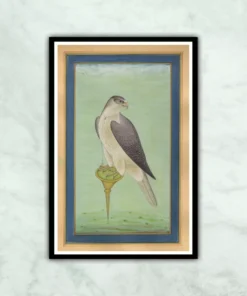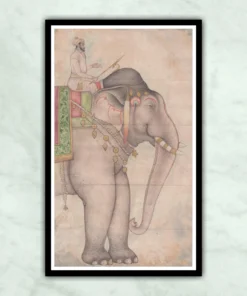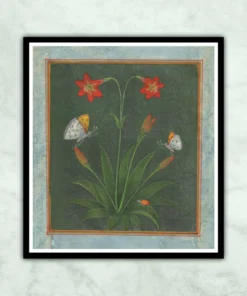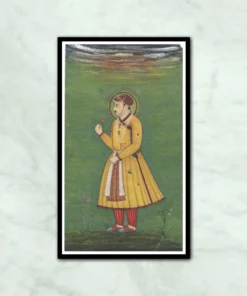Indian Miniature Paintings
Indian Miniature Paintings
Mughal Eagle of Akbar Emperor Miniature Painting – Hand Painted Miniature Art
Indian Miniature Paintings
Mughal Elephant Miniature Painting – Hand Painted Miniature Art
Indian Miniature Paintings
Indian Miniature Paintings
Mughal Golden Work Surahi Miniature Painting – Hand Painted Miniature Art
Indian Miniature Paintings
Mughal Handmade Portrait Painting – Hand Painted Indian Miniature Art
Indian Miniature Paintings
Mughal King Portrait Miniature Painting – Mughal Shaili Handpainted Miniature Art
Indian Miniature Paintings
Mughal Lady Pair Miniature Painting – Hand Painted Miniature Art
Indian Miniature Paintings
Mughal Lady With Horse Miniature Painting – Hand Painted Miniature Art
Indian Miniature Paintings
Mughal Turkey Cock Miniature Painting – Hand Painted Miniature Art
Buy Indian Miniature Paintings Online from India
Buy Indian Miniature Paintings online, including Mughal miniature portraits, art & paintings online at Artwale by emerging & professional artists. Shop Now!
Read More ▼
Decorate Your Home with Stunning Miniature Paintings
Indian painting has a very long tradition and history in Indian art, though due to climatic conditions, very few early examples survive. The earliest Indian paintings were the rock paintings of prehistoric times, such as the petroglyphs found in places like Bhimbetka rock shelters. Some of the Stone Age rock paintings found among the Bhimbetka rock shelters are approximately 10,000 years old.
India's ancient Hindu and Buddhist literature mentions palaces and other buildings decorated with paintings (chitra), but the paintings of the Ajanta Caves are the most significant of the few that survive. Smaller-scale painting in manuscripts was probably also practiced in this period, though the earliest survivals are from the medieval period. A new style emerged in the Mughal era as a fusion of the Persian miniature with older Indian traditions, and from the 17th century, its style diffused across Indian princely courts of all religions, each developing a local style. Company paintings were made for British clients under the British Raj, which from the 19th century also introduced art schools along Western lines. This led to modern Indian painting, which is increasingly returning to its Indian roots.
Indian paintings can be broadly classified as murals, miniatures, and paintings on cloth. Murals are large works executed on the walls of solid structures, as in the Ajanta Caves and the Kailashnath temple. Miniature paintings are executed on a very small scale for books or albums on perishable material such as paper and cloth. Traces of murals, in fresco-like techniques, survive in a number of sites with Indian rock-cut architecture, dating back at least 2,000 years, but the 1st and 5th-century remains at the Ajanta Caves are the most significant.
Paintings on cloth were often produced in a more popular context, often as folk art, used, for example, by traveling reciters of epic poetry, such as the Bhopas of Rajasthan and Chitrakathi elsewhere, and bought as souvenirs of pilgrimages. Very few survivals are older than about 200 years, but it is clear that the traditions are much older. Some regional traditions are still producing works.
Indian Miniature Paintings Shailis or Styles
Mughal Paintings
Mughal painting is a style of Indian painting, generally confined to illustrations on books and done in miniatures, which emerged, developed, and took shape during the period of the Mughal Empire between the 16th and 19th centuries. The Mughal style was heavily influenced by Persian miniatures and, in turn, influenced several Indian styles, including the Rajput, Pahari, and Deccan styles of painting.
Deccan Painting
Deccan painting was produced in the Deccan region of Central India, in the various Muslim capitals of the Deccan sultanates that emerged from the breakup of the Bahmani Sultanate by 1520. These were Bijapur, Golkonda, Ahmadnagar, Bidar, and Berar. The main period was between the late 16th century and the mid-17th, with something of a revival in the mid-18th century, by then centered on Hyderabad.
Rajput Painting
Rajput painting consists of four principal groupings:
- The Mewar school that contains the Chavand, Nathdwara, Devgarh, Udaipur, and Sawar styles of painting.
- The Marwar school comprising the Kishangarh, Bikaner style of painting from Bikaner, Jodhpur, Nagaur, Pali, and Ghanerao styles.
- The Hadoti school with the Kota, Bundi, and Jhalawar styles.
- The Dhundar school of Amber, Jaipur, Shekhawati painting, and Uniara styles of painting.
Pahari painting is the northernmost extension of the Rajput style, but usually treated separately.
Pahari Painting
The Pahari style, also referred to as the Punjab Hills style, developed and flourished during the 17th to 19th centuries, stretching from Jammu to Almora and Garhwal in sub-Himalayan India, through Himachal Pradesh. The Pahari paintings can be grouped into two categories: Jammu or Dogra school, and Basholi and Kangra school. Each created stark variations within the genre, ranging from the bold, intense Basohli painting, originating from Basohli in Jammu and Kashmir, to the delicate and lyrical Kangra paintings, which became synonymous with the style before other schools of painting developed.
Mysore Painting
Mysore painting is an important form of classical South Indian painting that originated in the town of Mysore in Karnataka. These paintings are known for their elegance, muted colors, and attention to detail. The themes for most of these paintings are Hindu Gods and Goddesses and scenes from Hindu mythology. In modern times, these paintings have become a much sought-after souvenir during festive occasions in South India.
Tanjore Painting
Tanjore painting is an important form of classical South Indian painting native to the town of Tanjore in Tamil Nadu. The art form dates back to the early 9th century, a period dominated by the Chola rulers, who encouraged art and literature. These paintings are known for their elegance, rich colors, and attention to detail. The themes for most of these paintings are Hindu Gods and Goddesses and scenes from Hindu mythology. In modern times, these paintings have become a much sought-after souvenir during festive occasions in South India.
Examples of Vernacular Indian Painting
Tribal Painting:
- Bhil painting
- Warli painting
- Gond painting
- Santhal painting
- Saora painting
- Kurumba painting
Rural Painting:
- Pattachitra painting
- Madhubani painting
- Kalamkari painting
- Kolam painting
- Kalam painting
- Mandana Paintings
Most Famous Indian Paintings
- Hemen Majumdar's "Lady with the Lamp"
- Sudip Roy's "Charulata Series"
- Rabindranath Tagore's "Self Portrait"
- Abanindranath Tagore's "Bharat Mata"
- Raja Ravi Varma's "Shakuntala"
- Ramkinkar Baij's "Jakkha 0 Jakkhi"
- Bikash Bhattacharjee's "Doll Series"
- Geeta Vadhera's "Jogia Dhoop Series"
- Jahar Dasgupta's "Confrontation"
- MF Hussain's "Horses Series"
- Jamini Roy's "Jesus"
- John Wilkins's "Gossip"
- Rakesh Vijay's "Persian and Mogul Styles"
- Jainul Abedin's "Series on Bengal Famine"
- Aman Singh Gulati's "Almond Portraits Series"
- Sunil Das's "Bull Series"
- Devajyoti Ray's "In Despair"
- Tyeb Mehta's "Mahisasur"
- B.G. Sharma's "Krishna Miniatures"
- Shakthi Dass's "Mother Teresa"
- M. Narayan's "Indian Ethnic Horses"
























